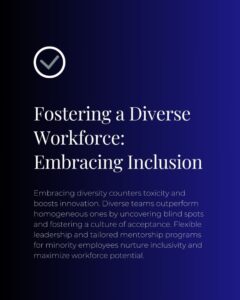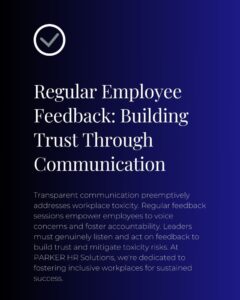- July 14, 2024
- Posted by: admin
- Category: Blogs

Cultivating a Healthy Work Environment: Insights from PARKER HR Solutions
Article By: Gifty Parker
As the Founder and CEO of PARKER HR Solutions, I’ve gleaned invaluable insights from real-life cases that underscore the pivotal role of fostering a diverse workforce and prioritizing regular employee feedback in maintaining a healthy organizational culture. Let’s delve deeper into these strategies and augment them with academic literature and hypothetical examples to illuminate their efficacy in preventing toxic workplace environments.

Fostering a Diverse Workforce: Embracing Inclusion
Embracing diversity not only enriches our organizational tapestry but also serves as a potent antidote to toxicity in the workplace. Research by Cox and Blake (1991) demonstrates that diverse teams outperform homogeneous ones due to their broader range of perspectives and innovative problem-solving approaches. For instance, consider a hypothetical scenario where a team comprising individuals from different cultural backgrounds collaborates on a project. Their diverse viewpoints enable them to identify blind spots and devise comprehensive strategies, fostering a culture of acceptance and understanding.
Moreover, dynamic strategies are crucial in navigating the complexities of managing diversity effectively. As highlighted by Thomas and Ely (2001), organizations must move beyond static approaches and embrace flexible leadership styles that accommodate diverse perspectives. For instance, implementing mentorship programs tailored to the unique needs of minority employees can facilitate their professional growth and foster a sense of inclusivity. By adopting such nuanced approaches, organizations can harness the full potential of their diverse workforce and create an environment where every voice is valued and respected.

Regular Employee Feedback: Building Trust Through Communication
Transparent communication channels serve as a linchpin in preempting toxicity in the workplace. Research by Detert and Burris (2007) underscores the pivotal role of regular feedback in addressing latent issues before they escalate into major crises. Consider a scenario where a company conducts quarterly feedback sessions to solicit employee input on organizational policies and practices. This proactive approach not only empowers employees to voice their concerns but also cultivates a sense of ownership and accountability, thereby fostering a positive work environment.
However, the implementation of feedback mechanisms often falls short due to leadership neglect. Drawing from Peters’ (1992) insights on genuine listening, leaders must prioritize active engagement with employee feedback to foster trust and openness. For instance, imagine a CEO who allocates dedicated time slots for listening to employee concerns and implements tangible changes based on their feedback. This proactive stance not only mitigates the risk of toxicity but also reinforces the organization’s commitment to employee well-being.
In conclusion, fostering a healthy work environment requires a multifaceted approach that integrates diversity and communication strategies. By leveraging insights from academic literature and hypothetical examples, organizations can proactively address the root causes of toxicity and pave the way for sustained success and growth. At PARKER HR Solutions, we remain steadfast in our commitment to creating inclusive workplaces where every individual thrives. Join us on this journey towards a brighter, more equitable future.
Author

Gifty Parker
Transforming businesses through innovative HR strategies, Gifty Parker is a CEO with profound expertise in Talent Acquisition, Learning & Development, and Performance Management. With a career dedicated to driving organizational success, Gifty champions a people-first approach, fostering workplace environments that empower individuals and cultivate excellence. Through her leadership at PARKER HR, she navigates the complexities of corporate leadership, intertwining personal experiences with a commitment to shaping a more inclusive future
Cox, T., & Blake, S. (1991). Managing cultural diversity: Implications for organizational competitiveness. Academy of Management Executive, 5(3), 45-56.
Thomas, D. A., & Ely, R. J. (2001). Cultural diversity at work: The effects of diversity perspectives on work group processes and outcomes. Administrative Science Quarterly, 46(2), 229-273.
Detert, J. R., & Burris, E. R. (2007). Leadership behavior and employee voice: Is the door really open? Academy of Management Journal, 50(4), 869-884.
Peters, T. J. (1992). Listening as a competitive strategy. Executive Excellence, 9(11), 11-12.

